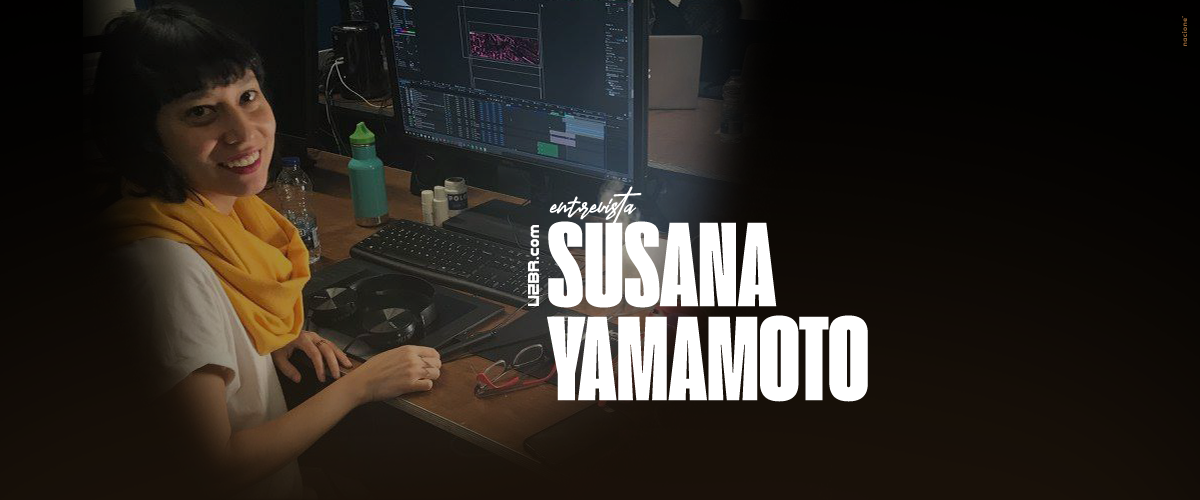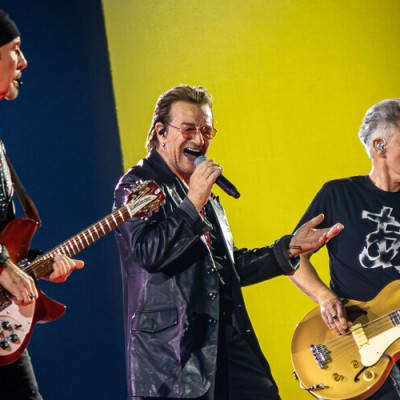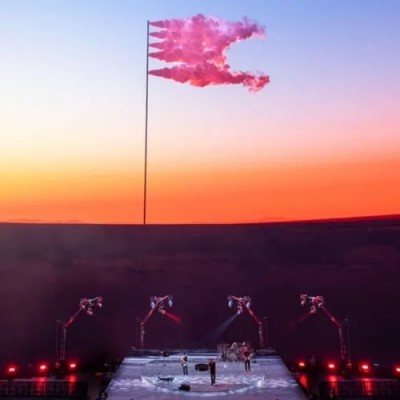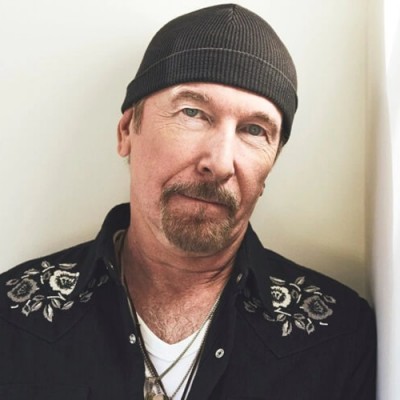Chegou o momento de encerrarmos nossa série de entrevistas especiais que a equipe preparou durante todo o ano de 2019. Desta vez trazemos para vocês uma entrevista exclusiva com a brasileira especialista em design de animação, Susana Yamamoto, que foi a responsável por criar o conceito por trás das imagens das mulheres para o momento "HerStory". Paulista, ela trabalhou não apenas com o U2, mas com outros nomes que vão de Rolling Stones a Ed Sheeran, passando por marcas tais como Louis Vitton e Kia Motors.
O U2 desde os early days foi uma banda focada em usar os recursos visuais ao seu favor durante as suas apresentações. Se no começo o foco ficava nas performances e na entrega de Bono no palco já que os recursos financeiros e a própria tecnologia não permitiam, com o passar dos anos os espetáculos da banda passaram a ser uma verdadeira imersão. Tudo o que poderia ser entregue no melhor do conceito visual para que os fãs mergulhassem no pequeno universo que cada tour quis apresentar, que envolvia desde um esquema de cores que se misturava entre a roupa dos integrantes, logos e as artes dos CDs passando por telões, cortinas de LED, uma emissora de TV particular e luzes sendo trazidas de dentro de carros... Como esquecer da enormidade do telão da PopMart, da sensação de estar rodeado pela banda na 360º ou da banda caminhando por dentro do telão nas últimas turnês em arenas?
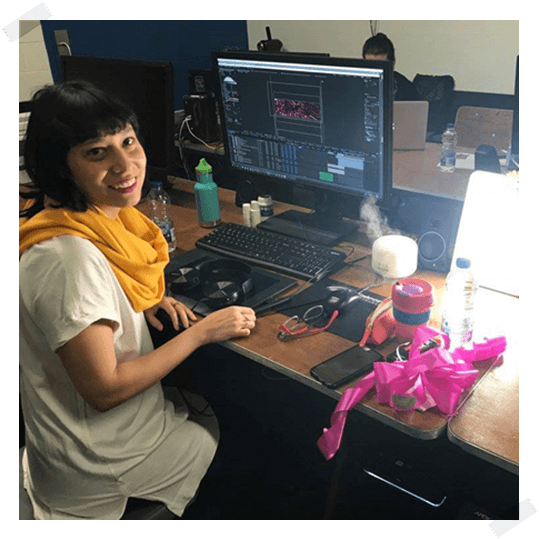 Na turnê comemorativa do The Joshua Tree Tour, que envolve o trabalho de Susana, a grande atração de toda a experiência – além de claro poder ouvir a obra-prima na íntegra – mais uma vez ficava por conta da enormidade do palco e do seu telão. Com dimensões de 61 metros de largura por 14 de altura, noite após noite ele ajudava a contar a história que a banda se propunha a mostrar em alta resolução. E foi com essa tecnologia que Susana pôde trabalhar, especialista em design de animação (“motion design”), estilo de trabalho gráfico que se foca em usar a tela para brincar com o tempo e o seu espaço, utilizando principalmente formas geométricas, ícones, textos e ilustrações que visam passar a sensação de fluidez.
Na turnê comemorativa do The Joshua Tree Tour, que envolve o trabalho de Susana, a grande atração de toda a experiência – além de claro poder ouvir a obra-prima na íntegra – mais uma vez ficava por conta da enormidade do palco e do seu telão. Com dimensões de 61 metros de largura por 14 de altura, noite após noite ele ajudava a contar a história que a banda se propunha a mostrar em alta resolução. E foi com essa tecnologia que Susana pôde trabalhar, especialista em design de animação (“motion design”), estilo de trabalho gráfico que se foca em usar a tela para brincar com o tempo e o seu espaço, utilizando principalmente formas geométricas, ícones, textos e ilustrações que visam passar a sensação de fluidez.
Confira a seguir esse nosso bate-papo com a artista e conheça mais sobre os outros trabalhos que ela realizou para a banda.
Conte um pouco sobre você, o que você faz e como você entrou no mundo do motion design.
Na verdade, foi muita sorte, eu morava na Inglaterra. Eu saí do colegial, não sabia muito o que fazer, resolvi aprender inglês. Fui para a Inglaterra, me apaixonei por Londres. E aí quando eu voltei para o Brasil, eu não queria entrar para a vida acadêmica. Eu não queria ser professora. Então minha amiga falou de uma faculdade de animação chamada Melies, acho que ainda deve existir, era um curso que durava um ano, chamava Voyage, que você aprendia a contar história, a parte 3D que é a modelagem e animação, um pouco de cinematografia. Eu amei o curso! Eu saí do curso, trabalhei um pouco no Brasil, nem um ano. Meu namorado é inglês, então eu resolvi voltar para Londres. Aí quando cheguei aqui meu portfólio era péssimo. Liguei para várias produtoras, inclusive uma era brasileira, chamava Samba Creative. Eles me acolheram e aprendi muita coisa lá. Muitas noites perdidas.
Quais foram os seus primeiros trabalhos?
Eu fiz muito trabalho corporativo no começo. Era um estúdio pequeno. Os primeiros trabalhos eu não lembro direito para qual companhia era. Você faz tanto trabalho, ainda mais quando é um estúdio pequeno para comercial. Acho que foi para a Tetra Pack, uma animação que a gente fez e ficou legal. O estúdio fechou e eu entrei na vida de freelancer. Conheci meu amigo Warren Chapman, que me chamou para trabalhar no Treatment Studio, companhia que estou até hoje, que trabalha com visuais para shows.
Como funciona o seu processo de design? De onde você tira inspiração e como você faz para unir o seu estilo pessoal com o dos seus clientes?
Acho que no começo não tinha essa de você colocar seu estilo, porque como era muito corporativo era bem “quadradão”, era mais no estilo da animação em movimento. Primeiro você vê qual é o tipo de trabalho, quem é o cantor, qual é o estilo, aí você busca um monte de referências e você monta um mural de todas as imagens para o artista aprovar e aí você faz testes de animação e vai mandando. E se eles gostarem, aprovarem... mas acho que isso é bem relativo, porque tem bandas que mudam até o último dia antes do show... eles querem mudar alguma coisa. Mas a gente tenta colocar nosso estilo pessoal, fazer alguma coisa que dê mais paixão... mas tem alguns trabalhos que é mais “tirar o leite da pedra” (risos).
Falando agora sobre a questão de contar uma história e o lado do design. Qual é mais importante para você? Ou há sempre uma conexão forte entre eles?
Eu tinha uma professora de português que falava que forma era conteúdo, na aula de poesia concreta. Então acho que quando você quer contar uma história, você tem que buscar o melhor jeito de expressar. Acho que os dois são importantes. Se você tem uma história boa, mas o jeito que você demonstra é ruim, ela não vai ser tão interessante. E se você mostra um filme com muitos efeitos especiais, e uma história ruim, ele também não vai ser interessante. Aliás, eu acho que é até melhor uma história boa com uma mídia fraca do que só efeitos especiais.
Como surgiu o convite para trabalhar com o U2? Havia algum projeto seu que chamou a atenção deles?
Esse estúdio que eu estou trabalha para vários artistas. Um dos diretores é o Willie Williams. Acho que eles têm um contrato de 10 anos com a banda, não sei de quando tempo, até eles pararem de tocar provavelmente. Meu primeiro trabalho para eles foi em 2015, eu fiz as ondas japonesas de “Until The End Of The World”, mas não cheguei a ir em turnê, foi a primeira vez que trabalhei com eles. E foi até legal porque, não sei qual diretor falou, acho que foi o Willie, que disse que o Bono tinha agradecido, que a banda tinha gostado muito. Normalmente, as bandas não falam isso diretamente para você. Achei simpático.
Depois teve a turnê de 2017, que eu cheguei a sair com eles, não posso chamar de tour, porque foi mais um ‘rehearsal’, que durou 2 meses, fomos para Houston e depois para Vancouver, quando eu fiz o HerStory. Nenhuma das ideias do show fui eu quem tive. Eu sou a pessoa que faz o design e a animação. Acho que quem teve essa ideia foi não sei qual membro da banda, acho que talvez o Bono.
Como era feita a escolha dos nomes?
Então, acho que a sobrinha do Willie conhece a Alice Wroe, ela é uma ativista feminista e ela estava fazendo esse projeto HerStory, então foi perfeito porque combinou e acho que como ela tinha pesquisado muito sobre isso, ela escolheu, mas eu sei que muita gente deu opinião porque até antes do show, uma hora antes do show eu estava trocando nomes de mulheres e mulheres, porque eles não conseguiam se decidir, quem ia e saía; teve até uma mulher, eu não vou lembrar o nome dela, ela estava no primeiro show de Vancouver, e se você pesquisar sobre ela, ela era uma criminal que tinha matado o marido (risos). Teve uma mulher da imprensa que perguntou: ‘mas porque essa mulher está lá?’. Na verdade, uma era branca e a outra era negra e rolou essa confusão, teve que tirar ela também, infelizmente.
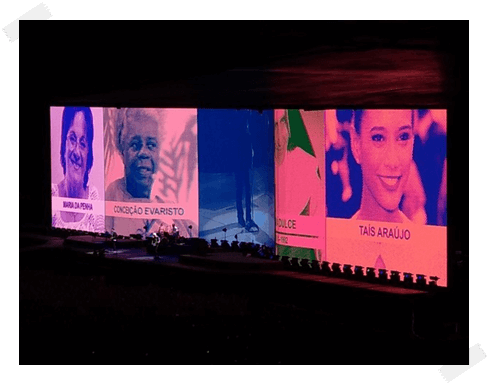 No Brasil, só para citar alguns nomes, tivemos Taís Araújo, Irmã Dulce, Maria da Penha, Tarsila do Amaral, entre outras. Houve alguma escolha pessoal da banda ou equipe dentre esses nomes?
No Brasil, só para citar alguns nomes, tivemos Taís Araújo, Irmã Dulce, Maria da Penha, Tarsila do Amaral, entre outras. Houve alguma escolha pessoal da banda ou equipe dentre esses nomes?
Não sei quem deu o pitaco final, mas o Adam é casado com uma brasileira, talvez ela também tenha ajudado a escolher. Mas nunca ninguém me perguntou, senão eu teria colocado minha mãe (risos).
Lembro que a ONE divulgou um formulário para os fãs brasileiros ajudarem a escolher...
Eu lembro que nesse tour de 2017, eu estava numa mesa jantando com o Willie e ele falou ‘é a primeira tour que eu vejo a banda trabalhar mais do que as pessoas’, e eu não sei se é verdade, porque todo mundo estava muito cansado.
Eu não sei como eles conseguem estar tanto tempo na estrada...
Nossa, eu não sei como, porque não é para mim. Mas eu imagino que eles queiram tirar um pouco de férias depois dessa tour.
Na verdade, eles já querem começar a gravar o novo álbum ano que vem (risos).
Ual! Nossa Senhora! Eu realmente não entendo como eles têm tanto pique, deve ser muito prazeroso (risos).
Você chegou a conhecê-los pessoalmente?
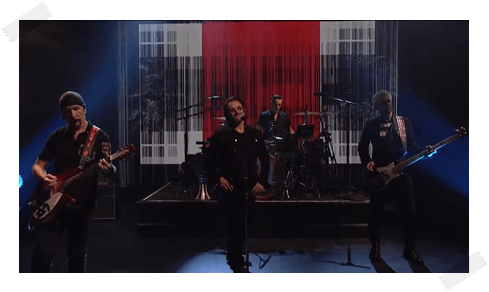 Teve uma vez durante a tour que foi uma emergência; eles foram fazer um show no Jimmy Fallon, tanto que eu voei com eles para Nova York para fazer o conteúdo do show. Acho que foi o meu contato mais próximo com eles. Eles foram supersimpáticos. É uma coisa meio profissional, você nunca vai se aproximar muito.
Teve uma vez durante a tour que foi uma emergência; eles foram fazer um show no Jimmy Fallon, tanto que eu voei com eles para Nova York para fazer o conteúdo do show. Acho que foi o meu contato mais próximo com eles. Eles foram supersimpáticos. É uma coisa meio profissional, você nunca vai se aproximar muito.
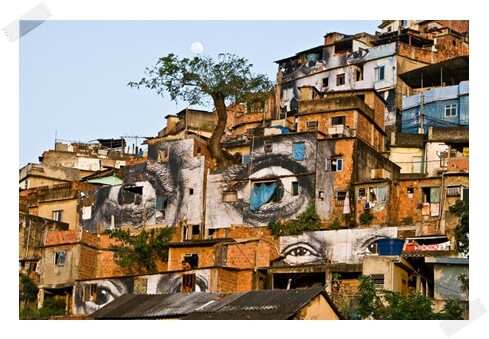 Você também foi responsável exclusivamente pela animação da apresentação do U2 no Rio Hudson durante o Grammy Awards 2018. O telão mostrava olhos de diversas pessoas que acompanhavam a música. De quem foi essa ideia? E quem são essas pessoas?
Você também foi responsável exclusivamente pela animação da apresentação do U2 no Rio Hudson durante o Grammy Awards 2018. O telão mostrava olhos de diversas pessoas que acompanhavam a música. De quem foi essa ideia? E quem são essas pessoas?
Eu perguntei para o Willie quem eram essas pessoas, ele disse que não sabia (risos). Mas a ideia foi daquele diretor francês chamado JR, ele fez aqueles olhos na favela do Rio. Então eu imagino que tenha uma história por trás dessas pessoas. Mas se o Willie não sabe, eu não tenho ideia (risos).
Quais outros gráficos tiveram a sua marca ou contribuição marcante durante as turnês do U2 para as quais trabalhou?
Fiz em 2017 para o MTV EMA na Trafalgar Square, eu e meu time fizemos os gráficos, mas eu fiz “Get Out Of Your Own Way”. Em 2018, fiz para “Vertigo” e “City Of Blinding Lights”, mas a parte visual de Tulsa, que eu sei que teve muitas mudanças, eles mudaram as cores e tudo mais. Depois desse primeiro show, eu não fui responsável por mais nenhum.
Teve algum mais desafiador ou que você goste mais?
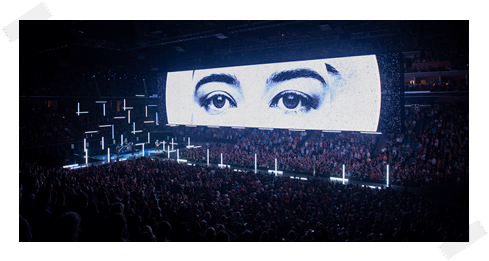 O mais desafiador acho que esteticamente foi o da MTV; eu gosto esteticamente bastante. Teve também o do Jimmy Fallon que eu editei a bandeira da Coreia do Norte com os Estados Unidos, acho que visualmente no show funcionou. As bandeiras também foram a coisa mais divertida que eu fiz na tour de 2017. Mas o mais difícil foi o de “City Of Blinding Lights”, porque no HerStory falaram ‘tem que fazer essa ideia’, não sei, gera conceito, uma estética, uma animação, aí eu fiz e a banda gostou na hora, foi muito rápido. Eu só tive que ir refinando, então para mim aquilo foi fácil, agora o que eu sofri foi “City”, porque foram cinco diretores que tinham opiniões diferentes. E eram opiniões muito diferentes. Então é muito difícil você criar alguma coisa quando todo dia se muda. Mas eu tive uma sorte que teve uma hora que o pessoal foi fazer outra coisa, aí eu consegui andar para frente com o projeto. Mas assim, foi bem desafiador (risos).
O mais desafiador acho que esteticamente foi o da MTV; eu gosto esteticamente bastante. Teve também o do Jimmy Fallon que eu editei a bandeira da Coreia do Norte com os Estados Unidos, acho que visualmente no show funcionou. As bandeiras também foram a coisa mais divertida que eu fiz na tour de 2017. Mas o mais difícil foi o de “City Of Blinding Lights”, porque no HerStory falaram ‘tem que fazer essa ideia’, não sei, gera conceito, uma estética, uma animação, aí eu fiz e a banda gostou na hora, foi muito rápido. Eu só tive que ir refinando, então para mim aquilo foi fácil, agora o que eu sofri foi “City”, porque foram cinco diretores que tinham opiniões diferentes. E eram opiniões muito diferentes. Então é muito difícil você criar alguma coisa quando todo dia se muda. Mas eu tive uma sorte que teve uma hora que o pessoal foi fazer outra coisa, aí eu consegui andar para frente com o projeto. Mas assim, foi bem desafiador (risos).
Nesta turnê de 2019 você não participou de nenhum projeto?
Não, eu parei em Tulsa em 2018. Foi a última vez que eu cliquei no mouse em qualquer gráfico. Quem está no meu lugar agora é o Brandon Kraemer, americano, ele adora ir nas tours, um ótimo editor, ele está adorando fazer os gráficos.
Cada artista ou banda apresenta características peculiares, mas com o U2 talvez isso seja ainda mais forte devido ao fato do grupo presar pelas artes visuais já desde os anos 80/90. Para você foi mais desafiador trabalhar com uma banda com esse histórico?
Não, em 2017 eu tive muita sorte porque eu acho que a banda estava tão ocupada pensando no novo álbum que eles me deram liberdade total para criar o que eu quisesse; já existia uma confiança da banda comigo. Foi bem legal.
Você está trabalhando em algo interessante para os próximos meses?
Ah, tem essa banda nova que chama Moscoman, ela é meio New Order, o cantor é de Israel e ‘tá’ sendo bem legal fazer os gráficos para eles. Eles deixam a gente criar o que quiser, eles estão adorando também o que estamos fazendo. Então isso é motivador para o final do ano. Teve o mês passado alguns projetos que você só ficando olhando para pixel, para partícula, animando partícula por um mês, pixel é bem chato. Então nesse final de ano ‘tá’ sendo ótimo pegar um projeto divertido.
Você tem alguma dica para dar para aqueles que desejam entrar nesse mundo?
Trabalhar com pessoas talentosas, que sejam legais, que dividam informação. E sempre estar curioso, aprender coisas novas, procurar softwares novos. Acho que você tem que gostar, estar sempre motivado, porque são tantas horas...
Tantas noites perdidas...
Nossa! É de chorar às vezes. Então você tem que gostar muito, senão é um desperdício de vida.
A equipe do U2BR gostaria de agradecer a gentileza de Susana por aceitar nosso convite e conceder um pouco do seu tempo para falar conosco. Nosso muito obrigado, Susana!
ENGLISH VERSION
It’s time to end our series of special interviews that our team has prepared throughout 2019. This time we bring you an exclusive interview with Brazilian motion designer Susana Yamamoto, who was responsible for creating the concept behind the images of women for HerStory moment. Born in Sao Paulo, she has worked not only with U2, but with other names ranging from The Rolling Stones to Ed Sheeran, to brands such as Louis Vitton and Kia Motors.
Since the early days U2 has been a band focused on using visuals to their advantage during their performances. If in the beginning the focus was on Bono's performances and on-stage delivery as financial resources and technology itself did not allow it, over the years the band's shows became a real immersion. Everything that could be delivered to the best of the visual concept for fans to immerse themselves in the small universe that each tour wanted to present, which involved a color scheme that blended between the clothing of the members, logos and the arts of CDs to screens. LED curtains, a private TV station and lights being brought in from cars... How to forget about the enormity of PopMart's big screen, the feeling of being surrounded by the band on 360º or the band walking inside the big screen on the latest tours in arenas?
On the commemorative tour of The Joshua Tree Tour, which involves Susana's work, the great attraction of the whole experience - and of course being able to hear the masterpiece in full - was once again the enormity of the stage and its big screen. Measuring 61 meters wide and 14 meters high, night after night it helped the band to tell the story set out to show in high resolution. And it was with this technology that Susana was able to work, motion design expert, a graphic work style that focuses on using the screen to play with time and its space, using mainly geometric shapes, icons, texts and illustrations that aim to give the sensation of fluidity.
Check out our chat with the artist below and learn more about the other works she has done for the band.
Tell us a little bit about yourself, what you do, and how you got into the world of motion design.
In fact, it was very lucky, I lived in England. I left high school and I did not know much what to do, so I decided to learn English. I went to England and fell in love with London. And then when I came back to Brazil, I didn't want to get into academic life. I didn't want to be a teacher so my friend talked about an animation college called Melies, I think it still must exist, it was a year long course called Voyage, that you learned to tell story, the 3D part that is modeling and animation, a bit of cinematography. I loved the course! I left the course and worked a little in Brazil, not even a year. My boyfriend is English, so I decided to go back to London. Although when I got here my portfolio was terrible. I called several producers, including a Brazilian called Samba Creative. They welcomed me and I learned a lot there. Too many lost nights.
What were your first works?
I did a lot of corporate work in the beginning. It was a small studio. The first jobs I don't quite remember which company it was for. You do so much work, especially when it's a small commercial studio. I think it was for Tetra Pack, an animation that we did and it was cool. The studio closed and I got into freelance life. I met my friend Warren Chapman, who called me to work at Treatment Studio, the company I am today, that works with visuals for concerts.
How does your design process work? Where do you get your inspiration from and how do you combine your personal style with that of your customers?
I don't think at first there was the chance of putting your style, because as it was very corporate it was like a "square", it was more in the style of moving animation. First you see what kind of work, who is the singer, what is the style, then you look for a lot of references and you create a mural of all the images for the artist to approve and then you do animation tests and send them. And if they like it, they approve it... but I think that's pretty relative because there are bands that change until the last day before the show... they want to change something. But we try to put our personal style, do something that gives more passion... but there are some jobs that is more "squeeze milk from a stone" (laughs).
Talking now about the storytelling and design side. Which one is more important to you? Or is there always a strong connection between them?
I had a Portuguese teacher who spoke what form was content in the concrete poetry class. So I think when you want to tell a story, you have to look for the best way to express it. I think both are important. If you have a good story, but the way you show it is bad, it won't be so interesting. And if you show a movie with a lot of special effects, and a bad story, it won't be interesting either. By the way, I think it's even better a good story with weak media than just special effects.
How did the invitation to work with U2 come about? Was there any project of yours that caught their attention?
This studio I'm working for works for a lot of artists. One of the directors is Willie Williams. I think they have a 10-year deal with the band, I don't know how long, until they probably stop playing. My first job for them was in 2015, I did the Japanese waves of “Until The End of the World”, but I didn't go on tour, it was the first time I worked with them. And it was really cool because, I don't know which director spoke, I think it was Willie, who said that Bono had been grateful, that the band had really enjoyed it. Normally, bands don't say that directly to you. I found it nice.
Then there was the 2017 tour, which I went out with, I can't call it a tour, because it was another rehearsal, which lasted 2 months, we went to Houston and then to Vancouver when I did HerStory. None of the ideas of the show were mine. I am the person who will do the design and the animation. I don’t know exactly which member had this idea, I think maybe Bono.
How was the choice of names made?
So, I think Willie's niece knows Alice Wroe, she's a feminist activist and she was doing this HerStory project, so it was perfect because it matched and I think as she had researched a lot about it, she chose it, but I know a lot people gave their opinion because even before the show, an hour before the show I was changing names of women, because they couldn't make up their minds who was going be in and out; there was even a woman, I won't remember her name, she was at the first show in Vancouver, and if you research her, she was a criminal who had killed her husband (laughs). There was a woman from the press who asked, "But why is this woman there?" In fact, one was white and the other black and so this mess happened, we had to remove her too, unfortunately.
In Brazil just to mention some, we had Taís Araújo, Sister Dulce, Maria da Penha, Tarsila do Amaral, among others. Was there any personal choice of band or team from these names?
I don’t know who gave the final word, but Adam is married to a Brazilian, maybe she also helped to choose. But no one ever asked me, otherwise I would have put my mother (laughs).
I remember ONE issued a form for Brazilian fans to help choose...
I remember that on this 2017 tour, I was at a table having dinner with Willie and he said 'this is the first tour I see the band working harder than people', and I don't know if it's true because everyone was very tired out.
I don't know how they can be on the road so long...
Wow, I don't know how, because it's not for me. But I imagine they want to take a little vacation after this tour.
In fact, they already want to start recording the new album next year (laughs).
Wow! Jesus! I really don’t understand how they have so much energy, it must be very pleasant (laughs).
Have you ever met them in person?
There was one time during the tour which was an emergency; they went to do a show at Jimmy Fallon and I flew with them to New York to do the show's content. I think it was my closest contact with them. They were supersympathetic. It's kind of a professional thing, you'll never get too close.
You were also solely responsible for animating U2's Hudson River performance during the 2018 Grammy Awards. The screen showed eyes of several people. Whose idea was this? And who are these people?
I asked Willie who these people were, he said he didn't know (laughs). But the idea was from that French director named JR, he made those eyes in Rio's favela. So I imagine he has a story behind these people. But if Willie doesn't know, I have no idea (laughs).
What other graphics had your mark or made a significant contribution during the U2 tours you worked for?
I did in 2017 for MTV EMA at Trafalgar Square, my team and I did the graphics, but I did “Get Out Of Your Own Way”. In 2018, I did it for "Vertigo" and "City Of Blinding Lights," but the visual part of Tulsa, which I know had a lot of changes, they changed the colors and everything. After this first show, I was not responsible for anything else.
Was there a more challenging work or one that you liked more?
The most challenging I think aesthetically was that of MTV; I like aesthetically enough. There was also Jimmy Fallon's that I edited the North Korean flag with the United States, I think visually the show worked. The flags were also the funniest thing I did on the 2017 tour. But the hardest was “City Of Blinding Lights”, because in HerStory they said 'you have to come up with this idea', I don't know, it generates concept, an aesthetic, an animation, then I did and the band liked it at the time, it was very fast. I just had to refine, so for me that was easy, the one that I suffered the most was "City" because there were five directors who had different opinions. And they were very different opinions. So it's very hard for you to create something when it changes every day. But I was lucky that there was a time when people went to do something else, so I was able to move forward with the project. But that was pretty challenging (laughs).
Have you not participated in any projects on this 2019 tour?
No, I stopped at Tulsa in 2018. It was the last time I clicked on any chart. Brandon Kraemer is in my place now, he is American and he loves to go on tours, he is a great editor and loves to do the graphics.
Each artist or band has peculiar characteristics, but with U2 this may be even stronger due to the fact that the group has stuck with visual arts since the 80s/90s. Was it more challenging for you to work with a band with this track record?
No, in 2017 I was very lucky because I think the band was so busy thinking about the new album that they gave me total freedom to create whatever I wanted; there was already a band trust with me. It was pretty cool.
Are you working on something interesting for the next few months?
Oh, there's this new band called Moscoman, it’s kind of New Order, the singer is from Israel and it's really cool to do the graphics for them. They let us create whatever we want, they are also enjoying what we are doing. So this is motivating for the end of the year. Last month there were some projects that we’re just looking at pixel for particle, separating particle for a month, pixel is pretty boring. So this holiday season it's being great to have a fun project.
Do you have any tips for those who wish to enter this world?
Work with good people, who are nice, who share information. And always be curious, learn new things, look for new software. You can never be lazy because every year there's a new software you'll need for the next show. I think you have to like it, always be motivated, because it's so many hours of work...
So many lost nights...
Wow! Tears will fall sometimes. So you have to like it a lot, otherwise it's a waste of life.
The U2BR staff would like to thank Susana for her kindness in accepting our invitation and giving a bit of her time to answer our questions. Thank you very much, Susana!
